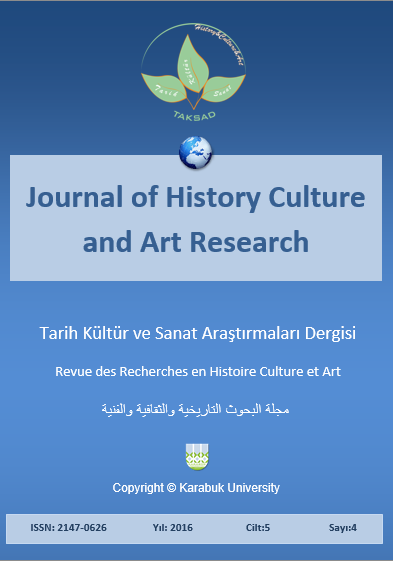Woman Transition from Myth to Interpretive-Literature: A Case-Study of Kashf al-Mahjub
DOI:
https://doi.org/10.7596/taksad.v5i4.597Anahtar Kelimeler:
Woman transition- woman in Islam- woman perception- primary sin- Israilites.Özet
Abstract
Women have been represented unpleasantly in most of the Persian literary texts. The apparent form of the Torah narration on the event of descent and imitation of some Islamic interpretative texts and repetition of the same concepts and contents in Persian literary texts such as Kashf-ul-Mahjub and Molana (Mawlana) works have caused these pessimistic views on the woman are rooted in the monotheism religions teachings. These thoughts and false beliefs are not assigned only to Iran and Persian literature, but it is a compressive thought that its example can be found in other cultures.
Some anthropologists believe in shaping of these false thoughts about women rooted in their physical weakness or their insignificant role in the family economy or the male historiography which these issues were effective in expansion of pessimistic views about women. Although women played an important role in myths period in shaping important events and the society economy, however, the base of pessimistic view about them dates back to these myths, the period that women had exalted social place which they lost their status. This article tries to respond following questions: What was the relationship between woman and man in myths period? Why did they lose their holiness suddenly? To what extent the mythical stories were effective in being guilty of woman in man primary sin? What was the effect of this issue in shaping the elements of the story of descent narrated by the mystical literature in old texts such as Kashf-ul-Mahjub and Molana works?
Referanslar
Atarzadeh, M. (2009). A Comparative Study of the Concept of Gender in Islam and the West. Women Strategic Studies, S. 11, No. 42.
Attar, Farid al-Din Mohammed (1993). Tazkera Al Oleya. The efforts of Mohammed Astelami, Tehran: pilgrims Zovvar.
Azizi, H. (2014). Scientific Status of Muslim Women in the History of Journalism. Historical Research Quarterly. 7:25, pp.85-102.
Bahar, M. (2002). From Myth to History. Third Edition. Tehran: Cheshma.
Bahar, M. (1994). Research on Iranian Mythology. Tehran: Agah Publishing.
Bahar, M. and A. Esmaeelpour (2004). Literature Manu. Tehran: Nshrkarnamh.
De Beauvoir, Simon (2003). The Second Sex. Translated by Qasim Snvy. Tehran: Tus.
Durant, William James (2001). Pleasures Philosophy. Translation Abbas Zaryab Sixth Edition. Tehran: The Training of Islamic Revolution.
Durant, William James (1998). History of Civilization, (the Orient, the Cradle of Civilization). Tehran: Organization of Islamic Revolution and training publications
Frazer, James George (2005). The Golden Bough (research in Magic and Religion), K. translations Firouzmand, Second Edition, Tehran: Agah.
Gademi, A. (2003). Women in Society. Iranian Association of Women's Studies. Tehran: Barge zayton.
Ghazali, Abu Hamid Muhammad ibn Muhammad (1991). Kemeya e saadat. Tehran: Almefarhange.
Ghazali, Abu Hamid Muhammad ibn Muhammad (1972). Nasehat al-Molok. To correct Jalal Homaei. Tehran: National Association of Iran.
Gray, John (1998). Near Eastern Mythology. Farokhi Bajalan translations. Tehran: mythology.
Gustav Jung, Carl (1997). Man and His Symbols. Translated by Mahmoud Soltanieh. Tehran: Jami.
Hjvyry (2005). Kashf al-Mahjub. Correction: Mohammad Amin Riahi, Tehran: Soroush Publication.
IsmailPur, Abulghasem, (2002). Myth Arfarn in Iain Manny with goftarydar Irfan Manave. Second Edition. Tehran: Karevan.
Jafary ye dehage, Mahmoud (2011). From Misogyny to Rural Women in Hadiqasanaee. Journal of Women and Culture, 3:9, pp.9-20.
Khaghani, Afzaleddin ibn Ali (1990). Books of Poetry. Ziaedden Sajjadinia correction. Third edition. Tehran: Zovvar.
Khalatbari Allahyar, Bahadur (2009). Critical Look at the Status of Iranian Women in Ancient Persian Texts (from the Beginning to the End Kharazmshahian Taherid) Moscow, 4:12, pp.87-108.
Komen, Franz (2001). Mithraic Mystery Cult. Translation by Razi Hashem. Tehran: Behjat.
Lahiji, Shahla and Kar (2002). Identity of Iranian Women. Tehran: Roshangaran.
Mashkoor, MJ (2001). Summary Religions. Sixth Edition. Tehran: Sharg.
McDonnell, Diane (2001). On the Front of Discourse Theory. Translated by Ali Hossein Nozari. Tehran: Farhang.
Mostagemi, Mahdieh Sadat (2010). Analyzed the Relationship Between Two Gender Valuable Quran Mystical. Cultural and Social Council of Women Quarterly, 13:29.
Mzdapvr, K. (1990). Social Life of Women in Iranian History. Tehran: Amir Kabir.
NAS, John (2003). A Comprehensive History of Religions. Ali Asghar Hekmat. Edition XIII. Tehran: Almefarhangi.
Nöldeke, Theodore (1972). The National Epic of Iran. Alavi translations. Tehran: Sphere.
Ruthven, K. (1999). Myth. Translation by A. Ismailpour. Tehran: Publication Center.
Saadi, Moslehaden Abdullah (1899). Bustan. Gholam Hossein Yousefi correction. Third edition. Tehran: Khwarizmi.
Sajadi, Syed Muhammad Ali (1999). Women and the Descent of Woman. Journal of Human Sciences: No. 57, pp. 161-186.
İndir
Yayınlanmış
Nasıl Atıf Yapılır
Sayı
Bölüm
Lisans
Tarih Kültür ve Sanat Araştırmaları Dergisi'nde yayımlanan tüm çalışmalar Creative Commons 4.0 CC-BY lisansı ile lisanslanmıştır.
Bunları yapmakta özgürsünüz:
- Bu eseri her boyut ve formatta paylaşabilir — kopyalayabilir ve çoğaltabilirsiniz.
- Materyalden Adapte et — karıştır, aktar ve eserin üzerine inşa et
- her türlü amaç için, ticari amaç da dahil
Alttaki şartlar altında:
Atıf — uygun bilgiyi, lisansa linki, and ve değişiklik yapıldıysa değişiklik bilgisinivermelisiniz. Sizi veya kullanımınızı lisansörün onayladığı bilgisini içermemek kaydıyla, size uygun şekilde bu işlemleri gerçekleştirebilirsiniz.
AynıLisanslaPaylaş — Eğer materyali karıştırdınızsa, aktardınızsa ya da materyalin üzerine çalıştınızsa, ancak aynı lisans ile dağıtabilirsiniz.
- Ek sınırlamalar yoktur — Lisansın izin verdiği hakları başkaları üzerinde kanunlarla ya da teknolojiyikullanarak sınırlayamazsınız.







